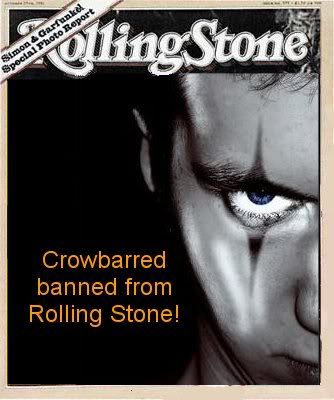Number 544 - George Jones

George Jones
"White Lightning"
(1959)
.
.
Genre:Country
 I wonder how this song came across in 1959, i mean, was it provocative or different even revolutionary? Or was Skiffle/Rockabilly commonplace around that time? In this countdown there is a song by Lonnie Donegan called "Tom Dooley" (Number 734) & that was dated 1958 Britain. So somewhere, someone influenced somebody in the 1950's. Yes, Skiffle was invented early 1900's by America, but I'm referring to "Electric Skiffle/Rockabilly" sound. George Jones is traditionally known as a "Country Singer" but i swear i can hear components of Skiffle sounding qualities, so its confusing when i read this statement in Wiki ....
I wonder how this song came across in 1959, i mean, was it provocative or different even revolutionary? Or was Skiffle/Rockabilly commonplace around that time? In this countdown there is a song by Lonnie Donegan called "Tom Dooley" (Number 734) & that was dated 1958 Britain. So somewhere, someone influenced somebody in the 1950's. Yes, Skiffle was invented early 1900's by America, but I'm referring to "Electric Skiffle/Rockabilly" sound. George Jones is traditionally known as a "Country Singer" but i swear i can hear components of Skiffle sounding qualities, so its confusing when i read this statement in Wiki .... "Skiffle had little impact in the United States beyond Donegan's hits, but some bands have imitated British accents. Only some would go as far as the Strapping Fieldhands and actually exhibit their skiffle roots".
I can only conclude that i have "White Lightning" confused for sounding like Skiffle, when in reality its just a Country song. But whatever the case, this is one helluva song!
early George JonesBy most accounts, George Jones is the finest vocalist in the recorded history of country music. Initially, he was a hardcore honky tonker in the tradition of Hank Williams, but over the course of his career he developed an affecting, nuanced ballad style. In the course of his career, he never left the top of the country charts, even as he suffered innumerable personal and professional difficulties. Only Eddy Arnold had more Top Ten hits, and Jones always stayed closer to the roots of hardcore country. Jones was born and raised in east Texas, near the city of Beaumont. At an early age, he displayed an affection for music. He enjoyed the gospel he heard in church and on the family's Carter Family records, but he truly became fascinated with country music when his family bought a radio when he was seven. When he was nine, his father bought him his first guitar. Soon, his father had Jones playing and singing on the streets on Beaumont, earning spare change.
 At 16, he ran away to Jasper, TX, where he sang at a local radio station. Jones married Dorothy, his first wife, in 1950 when he was 19 years old. The marriage collapsed within a year and he enlisted in the Marines at the end of 1951. Though the U.S. was at war with Korea, Jones never served overseas -- he was stationed at a military camp in California, where he kept singing in bars. After he was discharged, Jones immediately began performing again. Jones was on the road to success and Daily secured the singer a spot on the Louisiana Hayride, where he co-billed with Elvis Presley. Jones reached the Top Ten with regularity in 1956 with such singles as "What Am I Worth" and "Just One More." That same year, Jones recorded some rockabilly singles under the name Thumper Jones which were unsuccessful, both commercially and artistically.
At 16, he ran away to Jasper, TX, where he sang at a local radio station. Jones married Dorothy, his first wife, in 1950 when he was 19 years old. The marriage collapsed within a year and he enlisted in the Marines at the end of 1951. Though the U.S. was at war with Korea, Jones never served overseas -- he was stationed at a military camp in California, where he kept singing in bars. After he was discharged, Jones immediately began performing again. Jones was on the road to success and Daily secured the singer a spot on the Louisiana Hayride, where he co-billed with Elvis Presley. Jones reached the Top Ten with regularity in 1956 with such singles as "What Am I Worth" and "Just One More." That same year, Jones recorded some rockabilly singles under the name Thumper Jones which were unsuccessful, both commercially and artistically. Throughout 1958, he was landing near the top of the charts, culminating with "White Lightning," which spent five weeks at number one in the spring of 1959. His next big hit arrived two years later, when the ballad "Tender Years" spent seven weeks at number one. "Tender Years" displayed a smoother production and larger arrangement than his previous hits, and it pointed the way toward Jones' later success as a balladeer. Like his discography, Jones' personal life was spinning out of control. He was drinking heavily and began missing concerts. His second wife, Shirley, filed for divorce in 1968, and Jones moved to Nashville, where he met Tammy Wynette, the most popular new female singer in country music. Soon, Jones and Wynette fell in love; they married on February 16, 1969. At the same time Jones married Wynette, tensions that had been building between Jones and longtime producer Daily culminated. Jones was unhappy with the sound of his Musicor records, and he placed most of the blame on Daily. After his marriage, Jones wanted to record with Wynette, but Musicor wouldn't allow him to appear on her label, Epic, and Epic wouldn't let her sing on a Musicor album. Furthermore, Epic wanted to lure Jones away from Musicor. Jones was more than willing to leave, but he had to fulfill his contract before the company would let him go. ~ [Stephen Thomas Erlewine] {click this link for a comprehensive Bio}
Throughout 1958, he was landing near the top of the charts, culminating with "White Lightning," which spent five weeks at number one in the spring of 1959. His next big hit arrived two years later, when the ballad "Tender Years" spent seven weeks at number one. "Tender Years" displayed a smoother production and larger arrangement than his previous hits, and it pointed the way toward Jones' later success as a balladeer. Like his discography, Jones' personal life was spinning out of control. He was drinking heavily and began missing concerts. His second wife, Shirley, filed for divorce in 1968, and Jones moved to Nashville, where he met Tammy Wynette, the most popular new female singer in country music. Soon, Jones and Wynette fell in love; they married on February 16, 1969. At the same time Jones married Wynette, tensions that had been building between Jones and longtime producer Daily culminated. Jones was unhappy with the sound of his Musicor records, and he placed most of the blame on Daily. After his marriage, Jones wanted to record with Wynette, but Musicor wouldn't allow him to appear on her label, Epic, and Epic wouldn't let her sing on a Musicor album. Furthermore, Epic wanted to lure Jones away from Musicor. Jones was more than willing to leave, but he had to fulfill his contract before the company would let him go. ~ [Stephen Thomas Erlewine] {click this link for a comprehensive Bio}For Elvis Presley see Number 840
A George Jones legendary story....
Once, when I had been drunk for several days, Shirley decided she would make it physically impossible for me to buy liquor. I lived about eight miles from Beaumont and the nearest liquor store. She knew I wouldn't walk that far to get booze, so she hid the keys to every car we owned and left.
But she forgot about the lawn mower.
I can vaguely remember my anger at not being able to find keys to anything that moved and looking longingly out a window at a light that shone over our property. There, gleaming in the glow, was that ten-horsepower rotary engine under a seat. A key glistening in the ignition.
I imagine the top speed for that old mower was five miles per hour. It might have taken an hour and a half or more for me to get to the liquor store, but get there I did. ~ [Source:Wiki]
But she forgot about the lawn mower.
I can vaguely remember my anger at not being able to find keys to anything that moved and looking longingly out a window at a light that shone over our property. There, gleaming in the glow, was that ten-horsepower rotary engine under a seat. A key glistening in the ignition.
I imagine the top speed for that old mower was five miles per hour. It might have taken an hour and a half or more for me to get to the liquor store, but get there I did. ~ [Source:Wiki]
What does Kid Stone think about George Jones?
George Jones is the greatest pure singer in country music -- while his East Texas drawl identifies him both regionally and culturally, it doesn't cloud his remarkably clear and pliant voice, nor does it limit his astonishing vocal technique. But just as important is how profoundly Jones has bound himself to country music tradition, which for him is the religion that saved his life.His first #1 hit was J. P. Richardson's moonshiner novelty "White Lightning," with a panoply of vocal effects. ~ [From 2004's The New Rolling Stone Album Guide]
Rolling Stone Top 500 Songs ranked this song at Number (Not White Lightning, but 1 other) and the Album ranked at (Hey, cmon .. it was before our time)
Tags:George Jones, 1959, Country, Lonnie Donegan, Strapping Fieldhands, Hank WilliamsLennon, Eddy Arnold, Carter Family, YouTube, Elvis Presley, Rolling Stone Magazine, Tammy Wynette, New Zealand, Crowbarred Unleashed, The Definitive 1000 Songs Of All Time, Mellow Mix Volume 1, Mellow Mix Volume 2, Mellow Mix Volume 3, Mellow Mix Volume 4, Mellow Mix Volume 5, Mellow Mix Volume 6, Mellow Mix Volume 7, Mellow Mix Volume 9, Mellow Mix Volume 10, Mellow Mix Volume 11, Mellow Mix Volume 12 
By The Year 1955 to 2005:
1955, 1956, 1957, 1958, 1959, 1960, 1961, 1962, 1963, 1964, 1965, 1966, 1967, 1968, 1969, 1970, 1971, 1972, 1973, 1974, 1975, 1976, 1977, 1978, 1979, 1980, 1981, 1982, 1983, 1984, 1985, 1986, 1987, 1988, 1989, 1990, 1991, 1992, 1993, 1994, 1995, 1996, 1997, 1998, 1999, 2000, 2001, 2002, 2003, 2004, 2005

underlay
Labels: George Jones


















0 Comments:
Post a Comment
<< Home